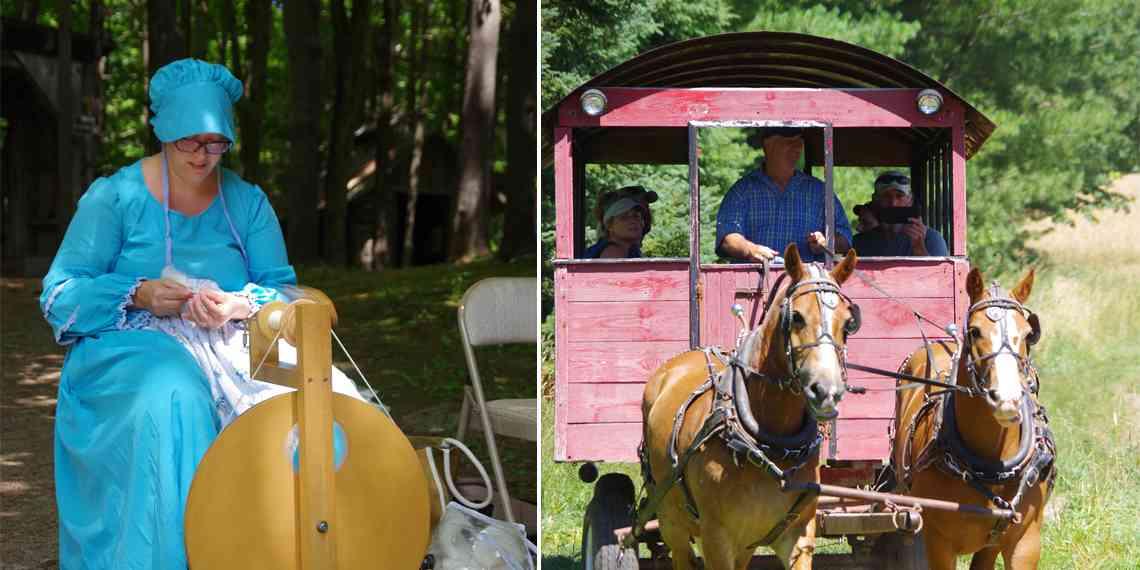
What was pioneer life like in the early 1800s in rural eastern Ontario? How did folks live, how did they earn a living, and what did they do for fun? Step back in time with the O’Hara family, where a visit to the O’Hara Mill Homestead and Conservation Area will include a history lesson and a taste of nature at its finest. Conveniently located in Madoc, half-way between Ottawa and Toronto close to Highway 7, and seventy kilometres from Peterborough, the eighty five acre property embraces a simpler time, and includes the thrill of a working mill and the romance of a covered bridge.
This treasure and its eventful history began with the O’Hara family, and involved a trip across the Atlantic and new beginnings. The year was 1789. At just twenty years of age, Patrick O’Hara left Londonderry in Ireland for the Americas, where five years on he married Cynthia Prindle – she just 15. Enter James O’Hara, one their nine children, who in 1823 with his wife Mary and four year old daughter Elizabeth, set up home in Madoc Township. The decision came as word spread that new lands for settlement had been made available by the British government.
The O’Hara Mill Homestead and Conservation Area, a registered charitable organization, is run solely by volunteers. Dave Little, board member with the O’Hara Volunteers Association, is known as ‘father O’Hara’ to many according to chairman Rod Woods. “He has been the driving force in bringing O’Hara to life”. Originally owned by Quinte Conservation, Little says the site was a pioneer farm, bought in 1955 by the Conservation Authority, mainly because they wanted to preserve the historic water powered sawmill on the property. Between the mid 50s and 2000, the mill and the property suffered hard times and as funds dried up the site fell into disrepair.
The O’Hara Volunteers Association put together a unique proposal that would allow them to take over the running of the property, and ultimately save it. “After considerable negotiations, a legal agreement was signed whereby the group had complete control of the management and operation of the historic farm,” said Little, who clarified that the Conservation Area still owns the site and pays the taxes on it. “From quite modest beginnings, we restored the sawmill, we built a new dam and a covered bridge, and we built several farm buildings to add to the site.” Materials for some of these were reclaimed from 1800s barns.
Little has been there from the beginning as he led the group through the initial two years of negotiations. With nineteen years of Homestead volunteering under his belt, he describes himself as a “continual presence” where he shows up at least five days a week, every week. He happily admits O’Hara Mill Homestead is his full time retirement passion, and calls himself lucky because not everyone in retirement has a chance play such a valuable role in their community.
“When I saw this place at the point of being abandoned and the absolute beauty of it and the absolute potential of it, I wanted to do something related to farming and this opportunity almost just jumped out at me.”
The O’Hara’s remained in Madoc for four generations. They are considered one of the founding families in the Madoc area, and likely the first settlers in the township, which also saw the first white child born in May 1826. Becoming a prosperous farming family thanks to the sawmill, they built the first school house in the township and were very involved establishing the Methodist church.. “They appear to have been very learned, because they left many photos, letters and journals,” said Little. “I just marvel at how many records we have of them, considering they came here with nothing.”
With around ten buildings on site, some original and some restored, others more recently constructed, visitors to the O’Hara Mill Homestead and Conservation Area can experience a one room schoolhouse, drive sheds, blacksmith’s shop, log house, carpenter’s shop and carriage house, all redolent of the period. And there is also the O’Hara Museum House, Visitors’ Centre and heritage gardens to be explored. Seven walking trails of various lengths up to almost two kilometres offer experiences of old growth forests, stacked stone walls and marshes to be enjoyed.
Remarkably, O’Hara Mill Homestead has never charged admission fees, accepting only donations. “We want families to feel that no matter how big they area or how many children they have, that they can afford to come and enjoy it,” says Little. He credits the rural sense of fellowship and the strong feeling of community for ensuring the Association is successful in its mission. Neighbours are always there to lend a hand, “Whenever I need help in any way it’s always there: it’s that old farm concept of neighbours helping neighbours.” With around twenty thousand visitors annually, Little explains how they have tried to avoid commercialism, ensuring the site remains very much the way it would have been in the 1800s. “Every week, I have two or three people say they really enjoy the serenity here and the naturalness, the sense that we are in an authentic pioneer farm.”
Enjoyed by all who come, especially families, visitors hail from many countries, but Little says the Irish that come are reminded of home and have a real sense of belonging. O’Hara Mill Homestead and Conservation Area grounds and trails are open year round, with buildings open Victoria Day weekend to Labour Day weekend. Guided tours and major events take place during the summer season, with smaller events, activities and demonstrations throughout the year, including Heritage Day, Christmas, Family Day, and a maple syrup event in March, done the pioneer way, just as the O’Hara’s would have had.
O’Hara Mill Homestead & Conservation Area
638 Mill Road, Madoc, ON
oharamill.ca



